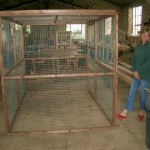Dogs & Fleas. Fleas have been around a while now and the chances of them continuing to be amongst us are very good. Unless you live in Alaska, Antarctica or some other place where there’s extreme cold, fleas are nasty little blood suckers that must be dealt with swiftly and severely. Remember, it was the fleas on the rats that spread the black plague.
Fleas are hardy little insects that live from 6-12 months. In only 1 year, a pair of fleas can produce millions of offspring that jump from 15-36 inches. This may not seem so impressive until you realize that if humans could jump like fleas, we would be leaping over 100 story buildings in a single bound.
 There are 4 stages to a flea’s life. The first flea stage, which is about 50% of the population, is eggs. A female flea lays 15-20 eggs every day. This means she can lay 600 or more eggs in her lifetime. Phase II of a fleas life is the “Larvae” stage where the tiny blood sucker develops. This is about 30% of the population. In Phase III, they’re called “Pupae” or “pre-adults” making up about 15% of the flea population. Phase IV is full on adult flea, the remaining 5%, that lives off the blood of your dog or any other warm blooded animal the flea can bite into including humans. Yuck!
There are 4 stages to a flea’s life. The first flea stage, which is about 50% of the population, is eggs. A female flea lays 15-20 eggs every day. This means she can lay 600 or more eggs in her lifetime. Phase II of a fleas life is the “Larvae” stage where the tiny blood sucker develops. This is about 30% of the population. In Phase III, they’re called “Pupae” or “pre-adults” making up about 15% of the flea population. Phase IV is full on adult flea, the remaining 5%, that lives off the blood of your dog or any other warm blooded animal the flea can bite into including humans. Yuck!
Fleas are tiny, relentless, disease carrying creatures. If your dog has fleas and it’s left untreated, your baby could end up with severe skin irritations, nasty infections, anemia or even tapeworms. Not to mention being horribly uncomfortable from the little creatures biting all day and night.
Dogs & Fleas
 If your dog is continually scratching, has scabs or dark specs on their body (which may be flea dirt), has red splotches, hot spots or obvious severe irritation, they may have FAD (flea allergy dermatitis). This can become serious literally overnight, so please see your Veterinarian and get the medication your canine needs.
If your dog is continually scratching, has scabs or dark specs on their body (which may be flea dirt), has red splotches, hot spots or obvious severe irritation, they may have FAD (flea allergy dermatitis). This can become serious literally overnight, so please see your Veterinarian and get the medication your canine needs.
On the other hand, your dog may not be scratching at all, but still may have fleas. Check your dog every day while you’re petting & loving on them. Give them a good brushing too. Most dogs love it. This is a great way to keep on top of any potential problems and reinforces the bond you already have with your canine family member.
To help get rid of fleas on your dog, first give them a bath with mild flea shampoo in cool (not cold) water (the cool water calms down irritated skin). Spray on doggie safe hydrocortisone (this can be purchased from your local pet store, your Veterinarian, or online) to help with the really sensitive hot spots and the general discomfort of having fleas continually biting and multiplying. After your dog is dry you still need to prevent any future infestations.
To prevent fleas, it’s best to get a once per month topical flea treatment that repels and kills fleas, tics and mosquitoes. The topical “Advantix” works like a super star. It’s placed on the skin in a few places every month and within 24-48 hours has completely covered your dog with a protective shield against fleas, tics & mosquitoes. It’s also waterproof after curing so it’s fine if your dog goes swimming or needs a bath. For those who prefer a more natural approach, there are many products available for your dog. The natural approach requires more diligence on your part but can often work well.
Now that you’ve treated your dog for fleas, it’s time to rid your house and your dog’s house of them. Fleas and their eggs end up on basically everything. The carpet, rugs, beds, blankets, clothing. Anything your dog had contact with or was within flea jumping distance. If you don’t rid your house of them now then you have not broken the cycle of flea infestation. So, since your dog has on their super shield flea repellent, then the little buggers are going to start looking elsewhere for fresh blood; like you, your guests or your children.
Generally a good washing of blankets, bedding and clothing in warm/hot water does the trick. Get some “20 Mule Team Borax” and mix it with your detergent (fleas don’t like borax). You can also sprinkle borax on your carpets, rugs & upholstery. Leave for a few hours and then vacuum really well. Be sure to discard the bag immediately. If your vacuum is bag less then clean out the container with bleach water. Be sure to discard the filter after your flea cleaning spree or the fleas, pupae & eggs you vacuumed up will continue to flourish.
Remember to clean the car and the dog house too!
An alternative to borax for your furniture, carpets, etc. is “Demize” which is an insect growth inhibitor (IGI) and can be purchased at most home and garden supply stores or online. Be sure to read all the instructions carefully. This is a chemical and must be handled responsibly.
If your dog had fleas, so does your yard. The best way to rid your yard of fleas is to destroy them with their natural enemy, “Nematodes”. Nematodes are microscopic worms (the good kind) that kill flea eggs and larvae. This equals 80% of the flea population. Nematodes are your friend. If you decide on Nematodes, start in shaded areas (direct sun kills these wonderful little creatures). You can buy Nematodes at your local pet supply store or home & garden store. Whichever method you choose, be sure to break the cycle of flea infestation.
The bottom line: Fleas are nasty, blood-sucking insects that not only bite and often carry parasites & disease but they multiply rapidly and get out of control fast. Kill the fleas now. Treat your dog for fleas now. Do what’s best for you and all your family members. Especially the furry ones. They count on you to care for them. Do a good job. The rewards are endless..
Note: Always talk with your Veterinarian before giving any oral or topical medications. This is especially critical if your dog has special needs or any other health issues.
Article by Miss Debra Rae. Miss Rae has been a poet & writer since college at UW, class of 1996. Visit her site for all your dog’s needs from training programs to nutrition, choosing a vet & books galore. Visit Good Poopy.com.







